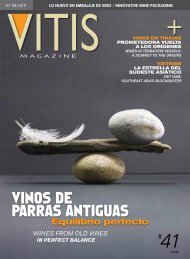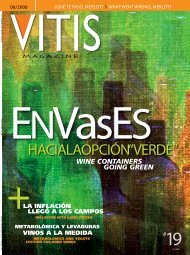You also want an ePaper? Increase the reach of your titles
YUMPU automatically turns print PDFs into web optimized ePapers that Google loves.
en sepia vintage shots<br />
hasta fines de<br />
la Colonia el<br />
Maipo solía ser<br />
navegable a partir<br />
del verano hasta<br />
comienzos de<br />
otoño, desde su<br />
desembocadura<br />
hasta Melipilla.<br />
Momofuku ssäm<br />
Las islas del Maipo corresponden a un accidente geográfico ya<br />
desaparecido por la acción humana. originalmente, aquella zona del<br />
curso medio del río, donde éste deja atrás el torrente que lo transporta<br />
desde la alta cordillera, apacigua su caudal permitiendo que se genere<br />
un fenómeno que los especialistas denominan “anastomosado”, lugar<br />
donde por acción del transporte de materiales del río se generan vados,<br />
terrenos inundables y pequeñas islas en el lecho, que se ensancha<br />
formidablemente. Las terrazas del río se desplazan en ambos sentidos<br />
de forma estacional, lo que en el caso del Maipo se materializa en dos<br />
crecidas al año.<br />
sabemos que hasta fines de la época colonial, el Maipo solía ser navegable<br />
a partir de comienzos del verano hasta mediados del otoño,<br />
desde su desembocadura en el pacífico hasta el “pueblo de indios” de<br />
Melipilla, por pequeñas embarcaciones que se internaban por Llo-Lleo<br />
hacia el oriente. Mucho antes, los indígenas de la cultura aconcagua<br />
transitaron esas rutas, desde la costa hacia el interior del valle, itinerario<br />
de transhumancia que seguía el camino de guanacos que iban tras las<br />
pasturas tiernas de la precordillera hasta las planicies litorales. Luego<br />
de sucesivas modificaciones iniciadas con la construcción de defensas,<br />
diques y canales desde finales del siglo Xviii y tras la construcción del<br />
embalse el Yeso en el siglo XX, que retiene gran cantidad de agua en la<br />
alta cordillera, el río fue progresivamente modificando su curso, siendo<br />
66 ▼ <strong>Vitis</strong> <strong>Magazine</strong> l novieMbre 2008<br />
a place where fords, floodplains and small islands<br />
are formed on the riverbed, which gets significantly<br />
enlarged. the terraces of the river move in both<br />
directions on a seasonal basis, which in the case of the<br />
Maipo means two rises of the river levels.<br />
We know that through the end of colonial times,<br />
people were able to navigate across the Maipo river<br />
since the beginning of summer to middle fall, from its<br />
mouth in the Pacific ocean to the “town of indians” of<br />
Melipilla, by means of small vessels that went into llolleo<br />
towards the east. Aconcagua culture indigenous<br />
people had long before traveled these routes, from<br />
the coast into the valley, a seasonal migration itinerary<br />
that followed the guanacos that traveled looking for<br />
the tender herbs of the lower cordillera to coastal<br />
plains. After successive changes that began with the<br />
construction of embankments, dikes and channels from<br />
late 18th century and after the construction of el Yeso<br />
dam in the 20th century, which holds plenty of water in<br />
the high mountain range, the river gradually changed<br />
its course, being contained in its permanent flow<br />
terraces, so the archipelago began fading away leaving<br />
at sight vast lands of the former “lonquén ford”<br />
(spanish word for the Mapuche term for “passage”)<br />
turned into infertile estates full of aggregate.<br />
EUROPEAN INFLUENCE<br />
the history of what we currently know as isla de Maipo<br />
shifted radically in early last century. As a result of the<br />
huge and adverse consequences of world wars, the<br />
Great depression (1929/30) and the spanish Civil War<br />
(1936/39), this quiet place witnessed the arrival of a<br />
great number of european families in the area, among<br />
which are spanish, italian, French, German and swiss<br />
immigrants. Many of them purchased these lands<br />
scorned by “distinguished” neighbors and with effort<br />
and perseverance they turned them into lands suitable<br />
for agriculture, under the skeptic eye of the so-called<br />
islanders. they built river defenses, sluices and trenches,<br />
turning a major part of the Mapocho old river band<br />
into a true agricultural land in less than twenty years.






